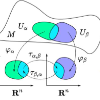Given a real, finite-dimensional, smooth parallelizable Riemannian manifold $(\mathcal{N},G)$ endowed with a teleparallel connection $\nabla$ determined by a choice of a global basis of vector fields on $\mathcal{N}$, we show that the $G$-dual connection $\nabla^{*}$ of $\nabla$ in the sense of Information Geometry must be the teleparallel connection determined by the basis of $G$-gradient vector fields associated with a basis of differential one-forms which is (almost) dual to the basis of vector fields determining $\nabla$. We call any such pair $(\nabla,\nabla^{*})$ a $G$-dual teleparallel pair. Then, after defining a covariant $(0,3)$ tensor $T$ uniquely determined by $(\mathcal{N},G,\nabla,\nabla^{*})$, we show that $T$ being symmetric in the first two entries is equivalent to $\nabla$ being torsion-free, that $T$ being symmetric in the first and third entry is equivalent to $\nabla^{*}$ being torsion free, and that $T$ being symmetric in the second and third entries is equivalent to the basis vectors determining $\nabla$ ($\nabla^{*}$) being parallel-transported by $\nabla^{*}$ ($\nabla$). Therefore, $G$-dual teleparallel pairs provide a generalization of the notion of Statistical Manifolds usually employed in Information Geometry, and we present explicit examples of $G$-dual teleparallel pairs arising both in the context of both Classical and Quantum Information Geometry.
翻译:暂无翻译




